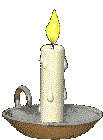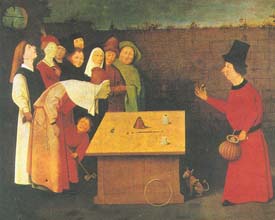
Magic in the Middle Ages

 |
Magic in the Middle Ages |
 |
I The Back Ground
I have been performing magic for several years but when I joined the S.C.A. One of the things I found surprising was how few people thought of magic as period. I had one person tell me "Oh, like in a role playing game, WE! don't do that here." Then I had to spend the next hour talking about cups and balls, appearing boxes, and the cut and restore rope tricks. Thankfully I had a good source for my information. A primary source that was above reproach, pictures to back it up and even a dictionary reference that defined magic as slight of hand. The kind gentle replied "The LARP'er meet on Friday" GERRRR!!!!!
Magic is not just people throwing spells in literature, and please don't confuse it with what some alternate religions do. Magic is and was the tricks and slights used by a Magician to entertain and or confuse his audience. The first thing we have to discuss is that the modern magician in the S.C.A. does not have nearly as many problems as the period magician would. Materials are more available and you don't have to go running from the Church (At least most of the time). On the down side is that your tricks are much wider known then they were in the medieval period. Most of the tricks now day enlist laughter instead of awh. So you have to either go for laughs or do the 6 to 10 tricks that still work and are impressive.
If you perform a trick at an event, most of the crowd will have seen it before, don't get upset if it's not appreciated. A good technique or patter can and does win a crowd but you still might not get the response you hoped for. Remember these are old tricks and you won't have the shock value of doing it for the the first time. You also have to remember that not everyone likes the same things. One of the first things I learned as a magician was the need for constantly adjusting the routine to the audience.
Lets talk what type of routine you can do. I have read many of the materials in mass print and have not found a complete routine from period Europe anywhere. Most sources have part of a routine or mention only one or two tricks that the person found amazing or was trying to explain. The most complete list of period tricks not in a routine is found in the Discovery Of Witchcraft By Reginald Scot, Published 1584. It can be found online at: http://www.conjuror.com/archives/discoverie/ Most of the tricks here are now in the public domain and can be used and taught with impunity.
II The Performance
First a question, What is the point of your show? Do you plan to make money from contributions, are you hired by an inn keeper to entertain and encourage the patrons to hang around and drink? Maybe you are selling lace and want to get a few extra coins, or you could be scamming the crowd for some reason. What you won't be doing is standing on a stage making elephants disappear. I have not found any stage magicians that performed for the general populace as they do now. There are performances for courts and rulers even in the worst of the witch hunts. But you don't see magic as a stage performance until post period.
The exception to this is the fairs. Here a magician got a chance to perform for lots of people at one time. He still didn't rate a stage but you would have many people around him watching his performance and making contributions to his general welfare, even if they didn't plan to.
| The Performer here is keeping the audience distracted while his partner is | |
 |
cutting the purse of the person
in front of him. I'm sure this is not a good thing to do in modern shows. If you
want to make money sell something, don't steal. The interesting thing is that the painting shows cups and balls one of the easiest and best of the period tricks still in general use today. The routine hasn't changed much from the |
| time it was first done in the early
days. Some of the historians think cups and balls is one of, if not the first trick
ever done. They base this on a painting in the Great pyramid of Gesa.
Other people including many in the magic field don't agree with this. The setup in
the painting is not the classic form for the trick and the other art work around the
painting are of games not magic tricks. And we know there were magicians in Egypt at
that time. I would think that the first trick would be some type of slight, used by a shaman before the age of recorded history. To support this I would have to point out that the witch doctors and faith healers of the South American Indians use slights as part of their "healing"programs. I think a palm of some type would have been very useful this purpose. We can also find a record for magicians in the bible. The tricks listed in the bible as performed by the magicians of the Pharaohs is quite elaborate and stunning for the time in which they were done. Though we now understand the process of many of the tricks, and even now are discovering more of their secrets, I think we will have many more things to learn from our Egyptian predecessors. |
|
III The Tricks
So it's time to start talking about the tricks. I'm not going to tell you how to do the tricks. If you want to learn them do what I had to do, go to the corner magic store and buy the books or join a magic club near you. What I do plan to do is list the tricks I have found to be from period.
This is just a small list of the trick available to a magician. But more then enough to start a show.
IV Bibliography